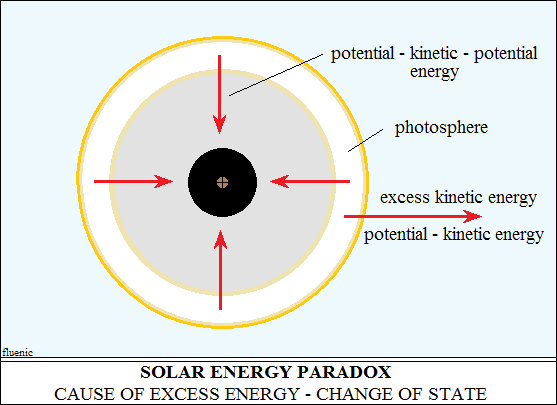The paradox of solar
energy.
The paradox consists in the fact that the energy emitted by the photosphere
in the vector space is comparable to the energy required by the vector
compressor, for the exponential increase of the vector pressure, of the
density of the oriented vector space. In the photosphere, the increase
in
pressure, in density, transforms the potential energy of the hydrogen
structures into kinetic energy emitted radially and centripetally.
Inward, the increasing pressure transforms the kinetic energy, the
oscillations, into potential energy of the solar core at zero K.
The paradox explained in the key of the materialist conception is attributed
to the thermonuclear reactions produced in the core of the sun, through
the
"collision of atomic nuclei". The vectorial interpretation has
already been
described: the compressor produces in the photosphere, the pressure and
density, which maintain decomposition and composition reactions of
hydrogen structures and implicitly, the abundance of the spectrum of
vectorial oscillations. The photosphere releases radially, the immense
kinetic energy, oscillations of the vector space - light. The potential
energy
of the hydrogen structures, thus returns again to the vector space, in
the
form of oscillations. Of course, the photosphere emits oscillations with
the
inner face of the layer as well. If up to the photosphere the pressure
of the
vector space included the structures of hydrogen gas, beyond the
photosphere, towards the center, the pressure becomes exclusively vector
space, oriented in orthogonally closed vector circuits. Therefore, the
kinetic
energy, the oscillations emitted by the photosphere inside,
becomes potential energy in the electric core, at zero K.
The cause of the excess energy.
Hydrogen structures are vector space compressed by the compressor,
potential energy at zero K. The immensity of kinetic energy emitted by
the
photosphere are effects of the decomposition of hydrogen vector structures
into oscillations. The pressure in the photosphere, transforming the potential
energy of the hydrogen structures into kinetic energy, in oscillations
lost in
vector space. The reality of this phenomenon, explains the paradox of
solar
energy. In the opposite sense, the vector oscillations emitted
by the inner surface of the photospheric layer are transformed
into potential energy, by the increase in compressor pressure.

